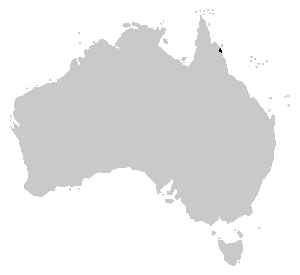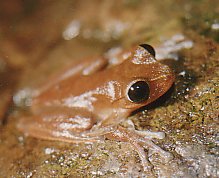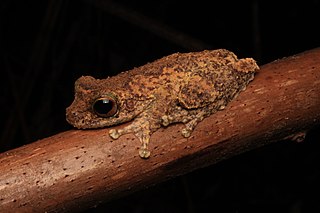
The white-lipped tree frog is a species of frog in the subfamily Pelodryadinae. It is the world's largest tree frog and is found in Australia. Other common names include the New Guinea treefrog, giant tree frog, and Australian giant treefrog.

The leaf green tree frog is a species of stream-dwelling frog, native to eastern Australia from the Queensland/New South Wales border south to Sydney.

The dainty green tree frog, also known as the graceful tree frog, is a species of tree frog in the subfamily Pelodryadinae. It is native to eastern Queensland, and north-eastern New South Wales, Australia and ranges from northern Cape York in Queensland to Gosford in New South Wales, with a small and most likely introduced population in Hornsby Heights in Sydney. It is the faunal emblem of the City of Brisbane.

The armoured frog, or armoured mist frog, is a species of tree frog in the torrent frog complex, a group restricted to north-eastern Queensland, Australia.

The striped burrowing frog is a species of burrowing frog in the subfamily Pelodryadinae of the family Hylidae. It occurs throughout much of Australia, from northern New South Wales, through eastern and northern Queensland and into eastern Northern Territory. This species was once included in the genus Litoria or Cyclorana.

The Australian lace-lid is a species of tree frog in the subfamily Pelodryadinae. It is endemic to the wet tropics of north-eastern Queensland, Australia.

The Booroolong frog is a species of stream-dwelling frog native to the Great Dividing Range in New South Wales, Australia. It is a member of the Hylidae, or the "tree frog" family. The Booroolong frog is classified by the IUCN as a Critically Endangered Species.

The green-thighed frog is a species of tree frog in the subfamily Pelodryadinae. Members of this species are medium-sized, ground-dwelling frogs, and are found in Australia.

The rough frog, also known as the woodland water-holding frog, warty water-holding frog, and red-backed cyclorana, is a species of treefrog native to northern New South Wales and south-eastern Queensland, Australia.

The common mist frog is a species of tree frog native to north-eastern Queensland, Australia. It is a medium-sized frog and a member of the Australian torrent treefrog group. The common mist frog is found in remote, mountainous areas, and near rocky, fast-flowing rainforest streams such as those in north-eastern Queensland, Australia. They are generally sedentary frogs, and remain in the stream environments that they are born into, preferring sections of the stream with riffles, many rocks, and overhanging vegetation.

The Centralian tree frog is a large species of tree frog native to a small area in central Australia. It is closely related to the Australian green tree frog, and closely resembles it in appearance.
The Cape Melville tree frog is a species of frog in the subfamily Pelodryadinae. It is endemic to Australia, and has been found only in Queensland, in Cape Melville National Park. Its natural habitats are subtropical or tropical moist lowland forests and rivers.
Beck's tree frog is a species of frog in the subfamily Pelodryadinae. It is endemic to Papua New Guinea. Its natural habitats are tropical moist montane forests, grasslands and streams. It was first described by the British biologist and herpetologist Arthur Loveridge in 1945 and is named in honour of the American ornithologist and explorer Rollo Beck who led the Whitney South Seas Expedition in the 1920s, collecting bird and other specimens from thousands of islands in the South Pacific.

The green-eyed treefrog is a species of Australasian treefrog in the subfamily Pelodryadinae that occurs in the Wet Tropics of Australia.

The bumpy rocket frog, also known as Peters' frog, is a species of frog in the subfamily Pelodryadinae. It is abundant and endemic to Australia, where it is found from northern Australia south to Maryborough, Queensland.
The Wendessi tree frog is a species of frog in the subfamily Pelodryadinae.
The mountain mist frog or Nyakala frog was a species of frog in the subfamily Pelodryadinae, endemic to Australia. Its natural habitats were subtropical or tropical moist lowland forests and rivers. It was threatened by habitat loss and potentially chytrid fungus, before being declared extinct in 2022.

The New England tree frog or glandular tree frog is a species of frog in the subfamily Pelodryadinae, endemic to Australia. Its natural habitats are temperate forests, subtropical or tropical moist lowland forests, subtropical or tropical moist montane forests, temperate shrubland, rivers, and pastureland. It is threatened by habitat loss.

Ranoidea wilcoxii, also known as the stony-creek frog, eastern stony creek frog, and Wilcox's frog, is a species of frog in the subfamily Pelodryadinae. It is endemic to Australia, being found solely on the eastern coast between Ingham, QLD, and Sydney, NSW, and as far west as Atherton, QLD. Its natural habitats are subtropical or tropical dry forests, subtropical or tropical moist lowland forests, rivers, intermittent rivers, and pastureland.

Ranoidea myola, commonly known as the Kuranda tree frog or Myola tree frog, is a critically endangered species of frog in the subfamily Pelodryadinae. It is endemic to the wet tropics of Australia.


















